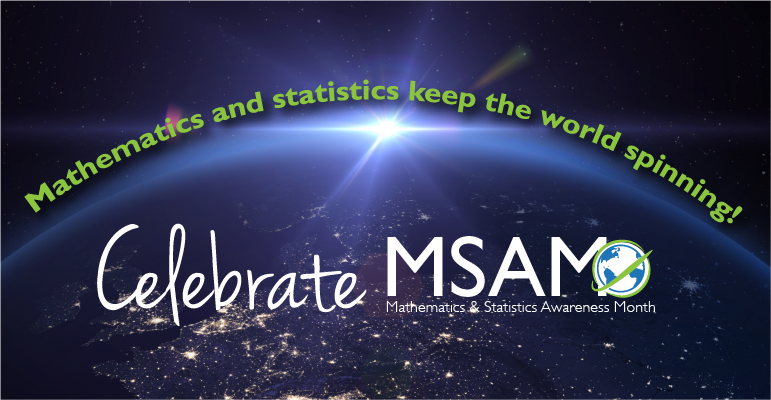Mathematics and Statistics Awareness Month

Activities
We encourage colleges and universities—and also high-school departments, institutional public information offices, math clubs, and student groups—and related associations and interest groups to organize and host activities in April for Mathematics and Statistics Awareness Month. Past activities have included workshops, competitions, exhibits, festivals, lectures, symposia, department open houses, math art exhibits, and math poetry readings. Some years, elected officials have issued proclamations, frequently in connection with special meetings and events arranged to observe the month.
This year, due to the coronavirus forcing schools to close and making it difficult to gather, we encourage you to celebrate mathematics and statistics on social media. Share your favorite math books, games, T-shirt designs, posters, news stories, videos, and research using hashtag #MathStatMonth.
Read about the origins of Mathematics and Statistics Awareness Month.
April marks a time to increase the understanding and appreciation of mathematics and statistics.
Why? Both subjects play a significant role in addressing many real-world problems—internet security, sustainability, disease, climate change, the data deluge, and much more. Research in these and other areas is ongoing, revealing new results and applications every day in fields such as medicine, manufacturing, energy, biotechnology, and business. Mathematics and statistics are important drivers of innovation in our technological world, in which new systems and methodologies continue to become more complex.
Basic research in mathematics is valuable in itself, but it often contributes to research in other sciences and has often, years later, led to discoveries that affect society today. For example, an encryption algorithm used today in e-commerce relies on results discovered in the 17th and 18th centuries, long before computers were invented. Mathematics has inspired some of the most stunning architecture and art.
In the age of big data, statistics underlies almost every decision made today, whether it's the effectiveness of a new drug or treatment or the debut of a new mobile device. Statistics is how analysts convert raw data into useful information, from studies of proteins to surveys of galaxies.
Research in statistics and the mathematical sciences is important for its applications and because it trains one in critical thinking and problem solving. From magic squares and Möbius bands to magical card tricks and illusions, mysterious phenomena with elegant "Aha!" explanations have been part of both subjects for centuries.
This April, let's celebrate mathematics and statistics and the diverse researchers and students in these fields who are contributing so much to furthering discoveries, solving problems, and finding beauty in our world.
Mathematics Awareness Month began in 1986 as Mathematics Awareness Week with a proclamation by President Ronald Reagan, who said in part:
Despite the increasing importance of mathematics to the progress of our economy and society, enrollment in mathematics programs has been declining at all levels of the American educational system. Yet the application of mathematics is indispensable in such diverse fields as medicine, computer sciences, space exploration, the skilled trades, business, defense, and government. To help encourage the study and utilization of mathematics, it is appropriate that all Americans be reminded of the importance of this basic branch of science to our daily lives.
In 1986, activities concentrated on national-level events, such as opening an exhibit at the Smithsonian Institution on mathematics and hosting a Capitol Hill reception. In 1999, Mathematics Awareness Week became Mathematics Awareness Month, held each year in April. Since that time, the focus has shifted to activities at the local, state, and regional levels. Over the years, the general purpose has consistently been to increase the visibility of mathematics as a field of study and communicate the power and intrigue in mathematics to a larger audience. Its goal is to increase public understanding of and appreciation for mathematics. Starting in 2017, the month's theme is Mathematics and Statistics Awareness Month, to celebrate mathematics and statistics and the diverse researchers and students in these fields who are contributing so much to furthering discoveries, solving problems, and finding beauty in our world.
The Math Forum hosted the Mathematics Awareness Month website until 2005.
Activities
Activities for Mathematics and Statistics Awareness Month are generally organized by college and university departments, institutional public information offices, student groups, and related associations and interest groups. They have included a wide variety of workshops, competitions, exhibits, festivals, lectures, and symposia. In some years, elected officials have issued proclamations for Mathematics Awareness Month, frequently in connection with special meetings and events arranged to observe the month.
The number and breadth of activities increase annually. For example, one college has sponsored a high-school mathematics day to encourage women to continue their studies in mathematics. At one university, two departments—mathematics and architecture—cooperated to plan and produce an interactive traveling exhibit that provided hands-on experience for such topics as codes, tilings, chaos, geometry, graphs, and computer science. That exhibit was used as a model for a mathematics exhibit at the Baltimore Museum of Science and Industry.
High schools are also involved in awareness activities. One school held daily contests, including a scavenger hunt and trivia quizzes, while others have enjoyed lectures given by mathematics faculty from nearby institutions.
Themes
In past years, a theme was selected, theme materials were developed and distributed, and groups shared their activities on the website.
To focus efforts and encourage participation, Mathematics and Statistics Awareness Month now offers resources for department chairs, selected high-school teachers, public policy representatives, and leaders of related associations to use and share throughout April—and throughout the year. JPBM welcomes the sharing of additional resources, supplemental links, updates, and activities on social media using #MathStatMonth.
Mathematics and Statistics Awareness Month information reaches thousands of faculty members, teachers, students, parents, public policy leaders, business persons, and other community members.